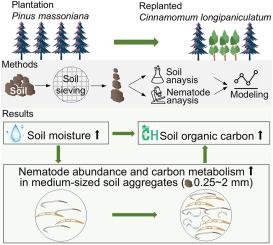人工林的近自然转化主要提高了中型土壤团聚体中线虫的丰度和功能
IF 8.4
2区 环境科学与生态学
Q1 ENVIRONMENTAL SCIENCES
引用次数: 0
摘要
采用“接近自然”的林业做法,使挣扎中的人工林恢复活力,在恢复土壤动物方面显示出希望。然而,这些修复工作背后的微观机制及其对土壤动物功能的影响仍然知之甚少。我们在马尾松(Pinus massoniana)人工林中改种本地阔叶树(Cinnamomum longipaniculatum),并在8年后研究了土壤团聚体中土壤线虫的变化。我们发现,无论块状土壤还是根际土壤,再植对不同土壤团聚体线虫群落的影响不同。具体而言,线虫丰度和碳代谢功能主要在中等大小的土壤团聚体(0.25 ~ 1和1 ~ 2 mm)中增加。这种改善与再植后土壤湿度的提高有关。同时,微生物生物量与线虫之间的联系随着群落大小的增加由负向正转变。线虫群落的这些变化最终导致了土壤有机碳含量的增加。综上所述,造林对中等团聚体土壤线虫群落的影响最大,最终调节了土壤碳循环。该研究为土壤线虫群落的微观恢复机制提供了有价值的见解。结果表明,在人工林经营过程中,增加中等团聚体的比例可以更有效地促进功能土壤群落的发展。本文章由计算机程序翻译,如有差异,请以英文原文为准。

Near-natural conversion of plantations primarily enhances the abundance and functionality of nematodes within medium-sized soil aggregates
Adopting "close-to-nature" forestry practices to rejuvenate struggling tree plantations has shown promise in restoring soil fauna. However, the micro-scale mechanisms behind these restoration efforts and their impact on soil fauna functions remain poorly understood. We replanted coniferous (Pinus massoniana) plantations with native broadleaf trees (Cinnamomum longipaniculatum) and studied the effects on soil nematodes within soil aggregates after eight years. We found the replantation influenced nematode communities differently across soil aggregates, regardless of the bulk or rhizosphere soil. Specifically, nematode abundance and carbon metabolism function ramped up mostly in medium-sized soil aggregates (0.25∼1 and 1∼2 mm). This improvement was linked to higher soil moisture levels resulting from the replantation. Meanwhile, the link between microbial biomass and nematodes flipped from negative to positive as aggregate size increased. These changes in nematode communities ultimately contributed to higher soil organic carbon content. In conclusion, the replantation exerted the strongest effects on nematode communities in medium-sized soil aggregates, ultimately regulating soil carbon cycling. This study provides valuable insights into the micro-scale restoration mechanisms of soil nematode communities. The results suggest that increasing the proportion of medium-sized soil aggregates could be more effective in promoting functional soil communities during plantation management.
求助全文
通过发布文献求助,成功后即可免费获取论文全文。
去求助
来源期刊

Journal of Environmental Management
环境科学-环境科学
CiteScore
13.70
自引率
5.70%
发文量
2477
审稿时长
84 days
期刊介绍:
The Journal of Environmental Management is a journal for the publication of peer reviewed, original research for all aspects of management and the managed use of the environment, both natural and man-made.Critical review articles are also welcome; submission of these is strongly encouraged.
 求助内容:
求助内容: 应助结果提醒方式:
应助结果提醒方式:


